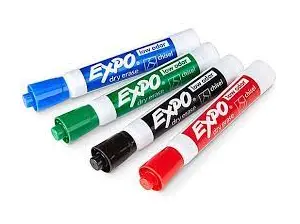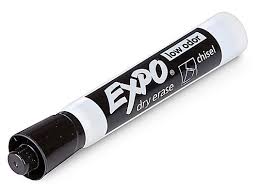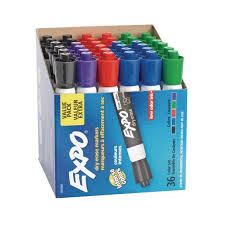Unveiling the Magic of Dry Erase Markers
Dry erase markers are writing instruments designed for use on smooth, non-porous surfaces, such as whiteboards. Filled with an alcohol-based ink, these markers offer vibrant colors and quick-drying capabilities. The ink's unique formulation allows for easy erasure with a dry cloth or eraser, making them popular tools for classrooms, boardrooms, and homes. To maximize their longevity, it's advisable to store them horizontally, cap them when not in use, clean the writing surface regularly, and avoid using them on porous materials. Refillable options and environmentally conscious formulations contribute to the versatility and sustainability of these markers across various industries.
The Chemistry and Applications of Dry Erase Markers

In the landscape of communication tools, the unassuming dry erase marker emerges as a silent hero, transforming blank surfaces into dynamic canvases for ideas and collaboration. From classrooms to corporate boardrooms, the dry erase marker has become an iconic symbol of interactive learning, strategic planning, and creative expression.
Composition of Dry Erase Markers: Unveiling the Alchemy of Effortless Erasure
The dry erase marker, with its remarkable ability to write and erase seamlessly, owes its magic to a carefully crafted alchemy of ingredients. Understanding the composition of these markers unveils the science behind their clean and efficient performance on whiteboards and other smooth surfaces.
- Plastic Barrel: At first glance, the dry erase marker appears as a sleek, often cylindrical, plastic pen. The plastic barrel serves as the outer casing, housing the components that work in harmony to deliver the ink onto the writing surface.
- Alcohol-Based Ink: The heart of the dry erase marker lies in its ink formulation. Unlike traditional markers or chalk, dry erase markers contain an alcohol-based ink. This ink is the secret sauce that allows for smooth writing, quick drying, and, most importantly, easy erasure.
- Pigments: The vivid colors of dry erase markers are the result of pigments suspended within the ink. These pigments impart color to the writing while maintaining the unique properties necessary for erasability. The pigments are finely ground to ensure a consistent flow and vibrant hues.
- Solvents: To keep the ink in a liquid state within the marker, solvents are introduced into the formulation. These solvents contribute to the rapid drying of the ink upon contact with the writing surface, preventing smudging and facilitating immediate use.
- Release Agents: The key to the erasability of dry erase markers lies in the presence of release agents. These are substances that prevent the pigments from bonding too strongly to the writing surface. Instead of adhering permanently, the ink sits atop the surface, allowing for effortless removal.
- Preservatives: To extend the shelf life of the markers, manufacturers often include preservatives in the ink formulation. These additives inhibit the growth of mold and bacteria, ensuring that the markers remain functional and reliable over an extended period.
- Low-Odor Formulas: Modern dry erase markers often feature low-odor formulations. This improvement addresses concerns about the pungent smell associated with earlier versions of these markers, making them more user-friendly, particularly in enclosed spaces like classrooms and offices.
How It Works: Unveiling the Choreography of Clean Expression
The marvel of the dry erase marker lies not just in its vibrant colors or convenient plastic casing, but in the intricate dance of chemistry that unfolds every time it meets a smooth surface. Understanding how dry erase markers work is akin to unraveling a well-choreographed performance, where each element plays a crucial role in the seamless interplay between ink and erasure.
- Contact and Ink Flow: When the tip of a dry erase marker makes contact with a smooth surface, the magic begins. The marker's tip, typically made of a porous material, acts as a conduit for the alcohol-based ink housed within the plastic barrel. As the user applies gentle pressure, the ink begins to flow, leaving a trail of vibrant color in its wake.
- Rapid Drying: Unlike traditional markers that can take time to dry, the alcohol-based ink in dry erase markers boasts rapid-drying properties. The solvents in the ink facilitate quick evaporation upon contact with the writing surface, ensuring that the written content dries almost instantly. This feature minimizes the risk of smudging and allows for immediate use.
- Pigmented Residue: The pigments suspended in the ink play a pivotal role in lending color to the writing. As the solvents evaporate, these pigments remain on the surface, creating a thin, pigmented residue. This residue, while visible and vibrant, is not bound permanently to the surface, thanks to the presence of release agents.
- Release Agents at Play: Release agents are the unsung heroes of the dry erase marker's functionality. These clever substances, integrated into the ink formulation, act as mediators between the pigments and the writing surface. Instead of allowing the pigments to form a tenacious bond with the surface, the release agents create a temporary connection. This temporary adherence is the key to the marker's erasability.
- Effortless Erasure: The moment of erasure is where the magic truly shines. Whether using a dedicated dry eraser or a soft cloth, the user applies gentle pressure to the pigmented residue. The release agents prevent the pigments from firmly reattaching to the surface, allowing the eraser to lift the residue effortlessly. The result is a clean surface, ready for new ideas, annotations, or revisions.
Evolution of Dry Erase Marker Technology: From Chalkboard Liberation to Eco-Friendly Innovation
The dry erase marker, a ubiquitous tool in classrooms, boardrooms, and households, has undergone a remarkable evolution since its inception. From its humble beginnings as a chalkboard alternative to today's eco-friendly innovations, the technology behind dry erase markers has continually adapted to meet the demands of users seeking convenience, sustainability, and enhanced functionality.
1. Chalkboard Liberation:
The mid-20th century marked a turning point in the way we conveyed information. Traditional chalkboards, while effective, were marred by dusty residue, smudging, and the need for water and sponges for erasure. Jerry Woolf's invention of the dry erase marker liberated educators and presenters from these constraints. The marker's alcohol-based ink, devoid of chalk's messiness, allowed for a cleaner, more efficient writing experience.
2. Ink Formulation Advancements:
As dry erase markers gained popularity, manufacturers focused on perfecting the ink formulation. Early markers were often limited in color options and had a tendency to dry out quickly. However, ongoing research and development led to improvements in ink formulations, resulting in markers with a broader array of vibrant colors, extended shelf life, and reduced odors.
3. Low-Odor and Non-Toxic Formulas:
One notable advancement in dry erase marker technology is the introduction of low-odor and non-toxic formulations. Recognizing the importance of user comfort, especially in enclosed spaces like classrooms and offices, manufacturers developed markers that emit fewer fumes and pose minimal health risks. This shift has contributed to a more pleasant and user-friendly writing experience.
4. Refillable Designs:
In response to environmental concerns surrounding single-use plastic, some dry erase marker manufacturers embraced refillable designs. These markers allow users to replace the ink cartridges rather than discarding the entire marker when the ink runs out. This not only reduces plastic waste but also provides a cost-effective and sustainable solution for long-term marker use.
5. Sustainable Materials:
The evolution of dry erase marker technology has extended beyond ink formulations to the materials used in manufacturing. Eco-conscious consumers now have access to markers made from recycled materials, contributing to the reduction of overall environmental impact. Sustainable sourcing and production practices are becoming integral to the marker industry's commitment to eco-friendliness.
6. Integration with Digital Platforms:
In the age of digital transformation, some dry erase markers have evolved to seamlessly integrate with digital platforms. Smart markers equipped with technology like Bluetooth connectivity and mobile applications allow users to capture and save their whiteboard creations digitally. This blending of traditional and digital methods enhances collaboration and information sharing in contemporary work and educational settings.
7. Nanotechnology and Enhanced Erasability:
Recent advancements in nanotechnology have also made their mark on dry erase marker technology. Some markers now boast improved erasability, with nanoscale innovations ensuring even smoother removal of ink residue. This enhances the overall user experience, making writing and erasing more effortless and efficient.
Applications Across Industries: The Versatility of Dry Erase Markers
The dry erase marker, once confined to the realms of classrooms and meeting rooms, has transcended its initial purpose to become an indispensable tool across a myriad of industries. Its versatility in fostering collaboration, communication, and organization has made it a staple in various professional settings.
1. Education: Transforming Classrooms into Interactive Spaces
In the realm of education, dry erase markers have revolutionized the way teachers impart knowledge and engage students. Whiteboards adorned with colorful markers have replaced traditional chalkboards, allowing for dynamic and interactive lessons. Teachers can illustrate concepts, encourage student participation, and make real-time modifications—all without the hassle of chalk dust or constant board cleaning. The versatility of dry erase markers supports various teaching methodologies, from brainstorming ideas to illustrating complex equations.
2. Business: Catalysts for Innovation and Strategy
In boardrooms and office spaces, dry erase markers have become synonymous with brainstorming sessions, strategic planning, and collaborative problem-solving. Whiteboards serve as blank canvases where ideas flow freely, and markers facilitate the visualization of concepts, timelines, and project workflows. The ease of erasure allows for quick adjustments and modifications during discussions, fostering a dynamic and adaptive work environment. From startups to multinational corporations, the use of dry erase markers has permeated every level of the business world.
3. Healthcare: Enhancing Communication and Organization
In healthcare settings, where clear communication is crucial for patient care and staff coordination, dry erase markers have become indispensable tools. Whiteboards in hospitals and clinics are used to display patient information, treatment plans, and staff schedules. The markers provide a quick and efficient means of updating information in real-time, ensuring that healthcare professionals stay organized and informed. The cleanliness of dry erase markers is particularly valuable in environments where hygiene is paramount.
4. Home: Facilitating Organization and Communication
Beyond professional settings, dry erase markers have found a place in households for a variety of purposes. Whether it's creating grocery lists, organizing family schedules, or leaving notes on the refrigerator, the markers offer a convenient and reusable solution for day-to-day tasks. The erasable nature of the ink allows for easy updates and modifications, making them a practical tool for family communication and organization.
5. Manufacturing and Engineering: Visualizing Processes and Workflows
In manufacturing and engineering, where intricate processes and workflows are at the forefront, dry erase markers serve as valuable tools for visual communication. Whiteboards in production facilities and design studios become dynamic spaces for mapping out workflows, tracking progress, and brainstorming ideas. The markers provide a tangible and collaborative way for teams to visualize complex concepts, fostering innovation and efficiency in product development.
6. Creative Industries: Sketching and Designing Ideas
In creative industries such as graphic design, architecture, and advertising, dry erase markers offer a tangible and versatile medium for sketching and conceptualizing ideas. Large whiteboards become creative canvases where teams can map out design concepts, storyboards, and marketing strategies. The markers' vibrant colors and ease of erasure make them ideal tools for the fluid and iterative nature of the creative process.
Does dry erase marker dissolve in water
Dry erase markers typically do not dissolve in water. The ink used in these markers is designed to be water-resistant and can be easily wiped off dry erase surfaces with a dry cloth or eraser. The ink is formulated with solvents that facilitate quick drying upon contact with a surface, and it creates a thin, pigmented residue that adheres temporarily to the surface.
If you were to expose a dry erase marker to water, the water would not dissolve the ink in the same way it might dissolve water-soluble substances like traditional marker ink or watercolor. Instead, the ink may resist water and remain on the surface until wiped away with a dry cloth or eraser.
Tips for Maximizing Dry Erase Marker Longevity
Maximizing the longevity of your dry erase markers involves a combination of proper storage, usage, and maintenance.
- Store Horizontally: To prevent the ink from drying out unevenly, store your dry erase markers horizontally. This allows the ink to distribute evenly throughout the marker, ensuring that the tip stays moist and ready for use.
- Cap When Not in Use: Always cap your markers when not in use. This simple step prevents the ink from being exposed to the air, slowing down evaporation and helping to maintain the freshness of the marker. Make sure the cap is securely in place to create an airtight seal.
- Avoid Pressing Too Hard: Applying excessive pressure when writing can wear out the tip of the marker more quickly. Instead, use a gentle touch. Dry erase markers are designed to write smoothly with minimal pressure, so let the ink flow naturally.
- Clean the Whiteboard Regularly: A clean whiteboard is essential for optimal marker performance. Regularly clean your whiteboard with a dry eraser or a damp cloth to remove any residue. This prevents a buildup that could affect the markers' erasability.
- Use a Quality Whiteboard: The quality of the writing surface matters. Invest in a high-quality whiteboard to ensure smooth writing and easy erasure. Cheaper, lower-quality boards may cause markers to wear out more quickly and compromise the writing experience.
- Avoid Using on Porous Surfaces: Dry erase markers are designed for smooth, non-porous surfaces like whiteboards. Avoid using them on porous materials as the ink may be absorbed, making it difficult to erase and potentially shortening the life of the marker.
- Re-Cap Promptly: When you're done using a marker, cap it promptly. This prevents the ink from drying out due to prolonged exposure to the air. If the cap is left off for an extended period, the marker may become less effective or dry out completely.
- Keep in a Controlled Environment: Store your dry erase markers in a controlled environment, away from extreme temperatures and direct sunlight. High temperatures can cause the ink to evaporate more quickly, while extreme cold can affect the consistency of the ink.
- Refillable Markers: Consider using refillable dry erase markers. Some models allow you to replace the ink cartridge, reducing plastic waste and providing a cost-effective solution for long-term use.
- Rotate Markers Regularly: If you have multiple dry erase markers in use, rotate them regularly. This helps ensure that all markers are used consistently, preventing one from drying out while others remain active.
The dry erase marker has evolved from a simple writing tool to a symbol of modern communication and collaboration. Its invention addressed a practical need for a cleaner, more efficient alternative to traditional writing implements, and its continued evolution has only strengthened its position in various aspects of our lives. From classrooms to boardrooms, healthcare facilities to homes, the dry erase marker remains a constant companion in our quest for effective communication and organization.





